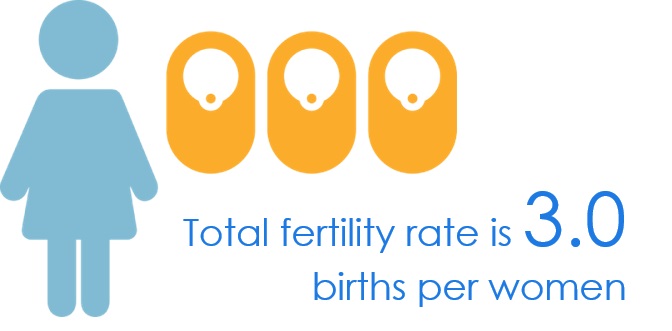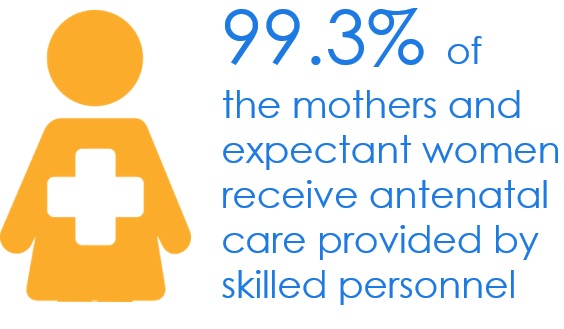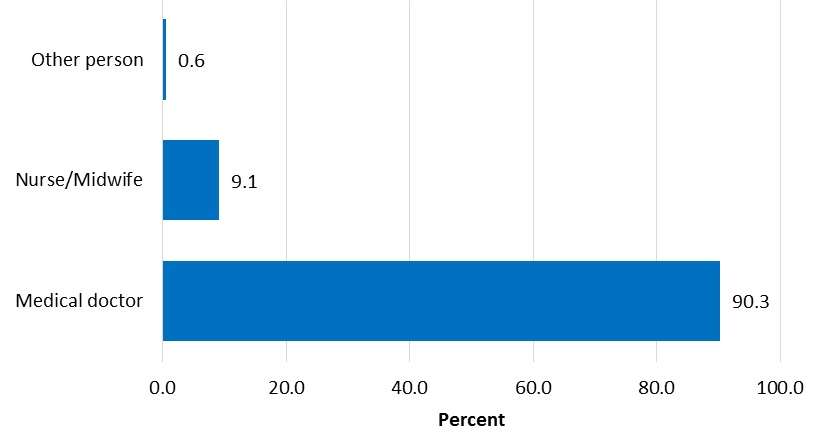In MICS, age specific and total fertility rates are calculated by using information on the date of last birth of each woman and are based on one-year period (1-12 months) preceding the survey.
In Kazakhstan, the crude birth rate among women aged 15-49 years is 21 births per 1,000 population, in urban and rural areas this figure is 20 and 23 births per 1,000 population, respectively. The adolescent birth rate among girls aged 15-19 years is 36 births per 1,000 women.

The total fertility rate for the one year preceding the Kazakhstan MICS is 3.0 births per woman aged 15-49 years, in rural areas this figure is higher than in urban areas (3.7 births and 2.6 births respectively).
There are differences in the age-specific fertility rates of women from urban and rural areas, which are especially pronounced among women aged 20-24 years: while in the urban areas there are 148 births per 1,000 women in this age group, in rural areas the fertility rate is more than twice as high (304 births per 1,000 women).
For women aged 15-49 years there were no cases of births the age of 15 years. 3.9 percent of women of the age 15-49 years have already had a live birth, while 1.4 percent of women in this age group are pregnant with their first child. The percentage of women aged 20-24 years who have had a live birth before age 18 is 2.2 percent. In addition, women in this age group with lower education levels are more likely to have had a live birth compared to those with higher education (15.7 and 0.5 percent respectively).
Appropriate family planning is important to the health of women and children by: 1) preventing pregnancies that are too early or too late; 2) enabling the period between births to plan timing of childbearing, distributed over time, the so-called interval between successive births; and 3) limiting the total number of children. According to the WHO definition, "family planning is ensuring control of the reproductive function for the birth of healthy and wanted children". Therefore, access by all couples to information and services to prevent pregnancies that are too early, too closely spaced, too late or too many is critical.
In Kazakhstan, almost all women aged 15-49 years (98.8 percent) are informed about a contraceptive method, including modern methods.
The most popular method of contraception is the intrauterine device (IUD), which is used by every third women currently married or in union (31.9 percent). The next most commonly used method/means of contraception is the male condom, the use of which is reported by 12.5 percent of women currently married or in union, while more than 6 percent of the women use the pill.
Methods/means of contraception such as an injection, diaphragm/foam/gels, lactational amenorrhea method (LAM), withdrawal or periodic abstinence, and female sterilization, are used by 0.1 – 1.7 percent of women.
Adolescents aged 15-19 are much less likely to use methods of contraception than older women (20- 49 years).
Coverage of pregnant women during the antenatal period with medical and preventive activities is very important and vital to their health and well-being, as well as for the health and well-being of their children.

In Kazakhstan coverage of antenatal care by skilled health personnel, is very high and amounted to 99.3 percent.
Antenatal care for pregnant women was predominantly provided by qualified doctors (92.2 percent), for 6.6 percent of pregnant women – by nurses or midwives, and for 0.5 percent – by feldshers, with these two categories of mid-level medical personnel to be mostly typical for rural areas (10.8 and 1.0 percent respectively) .
Who recommends a minimum of four antenatal visits based on a review of the effectiveness of different models of antenatal care. In Kazakhstan 95.3 percent of pregnant women received antenatal care at least four times.
Overall, 90.2 percent of women who had live birth in the past two years, had the first visit to the health care professionals for antenatal care in the first trimester of their last pregnancy, with a median of 2-month pregnancy at the time of the first visit.
In the first trimester of pregnancy the first visit to health workers for antenatal care was undertaken by only 82.9 percent of women younger 20 years at time of birth, compared with 91.1 percent of mothers aged 20-34 years at time of birth.
About three quarters of all maternal deaths occur due to direct obstetric causes. The skilled attendant at delivery indicator is used to track progress toward the Millennium Development Goal 5 of improving maternal health, as well as for recently adopted Sustainable Development Goals.
In Kazakhstan, 99.4 percent of births were attended by qualified personnel and practically all births took place in public health facilities.
More than 90 percent of births in Kazakhstan were delivered with assistance of doctors, and 9.1 percent of births – by nurses and midwives.

In general, 14.8 percent of births were conducted by caesarean section. Thus, 9.6 percent pregnant women have consented to the operation before the start of labour, and for 5.3 percent of pregnant women the decision was made during labour.
The time of birth and immediately after is a critical window of opportunity to deliver lifesaving interventions for both the mother and newborn. Across the world, approximately 3 million newborns annually die in the first month of life and the majority of these deaths occur within a day or two of birth, which is also the time when the majority of maternal deaths occur.
In Kazakhstan, nearly every woman who gave birth in a health care facility stays there for 12 hours or more after delivery (99.9 percent), with virtually no regional differences. Almost nine out of ten women (89.0 percent) stayed in health facilities for 3 or more days after delivery; of which 44.4 percent stayed in health facilities exactly 3 days after birth and 11.0 percent of women were in health facilities at least 3 days after delivery.
Results of the 2015 Kazakhstan MICS showed that for 97.4 of live births, both the mothers and their newborns receive either a health check following birth or a timely PNC visit, within two days of the most recent birth, whereas for 0.6 percent of cases after childbirth, both the mothers and their newborns neither received health checks or timely visits, and in 1.9 percent of cases – only newborns received this care. In general, both urban and rural mothers and their newborn children alike were provided health checks and timely PNC visits within two days of the most recent birth (98.3 and 96.5 percent, respectively). Differences depending on other background characteristics are minimal.
In Kazakhstan, one in five women (20.1 percent) aged 15-49 had at least one induced abortion during their lifetime.
The highest percentage of women who have had 2-3 or 4 and more abortions is observed among women in the age group of 40-44 years and 45-49 years (46.2 and 45.4 percent, respectively, and 7.0 and 8.4 percent respectively).
The total abortion rate is 0.3 per 1 woman aged 15-49 years, while the general abortion rate is 10 abortions per 1,000 women.